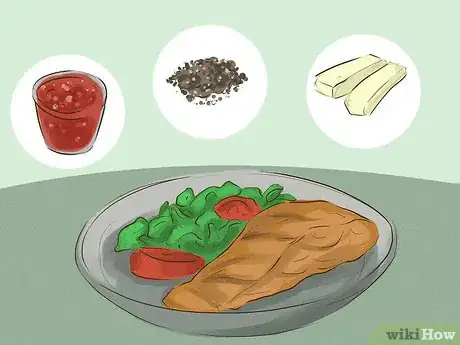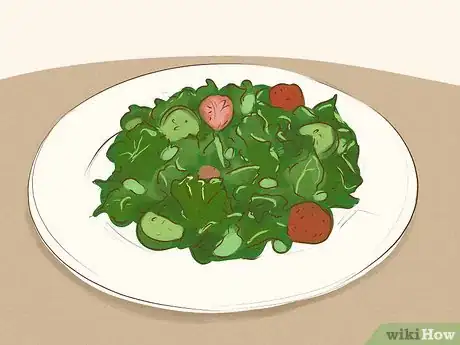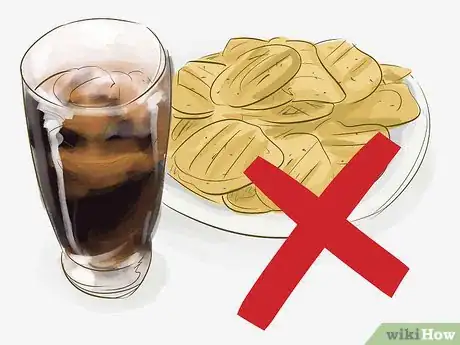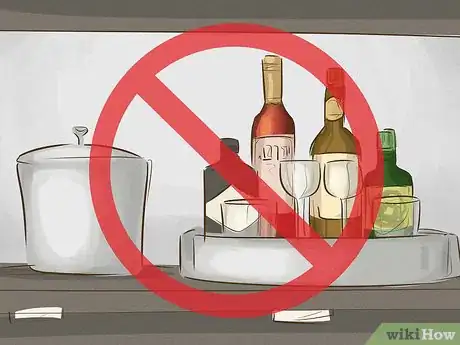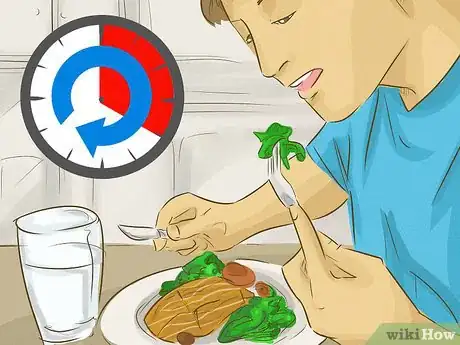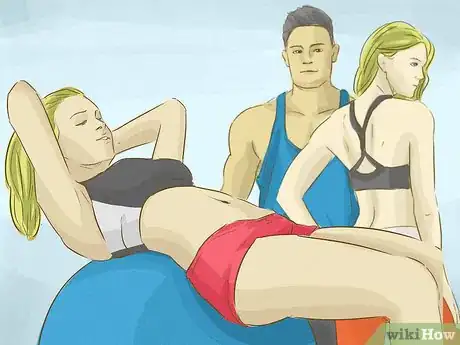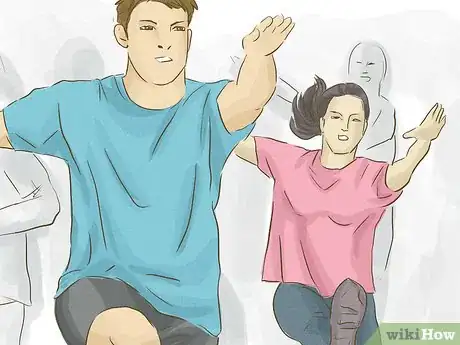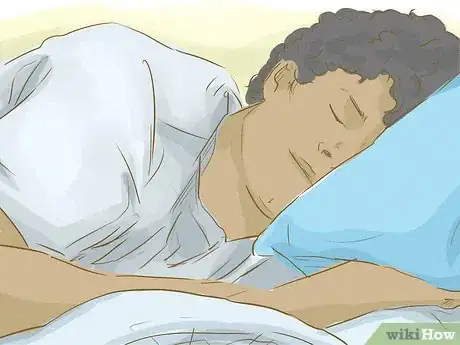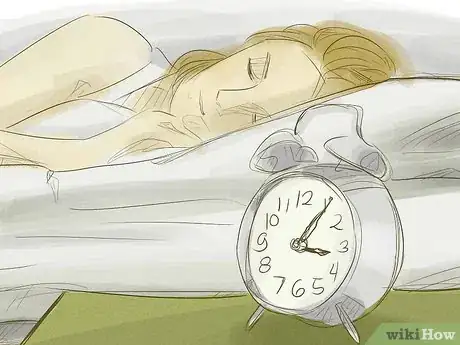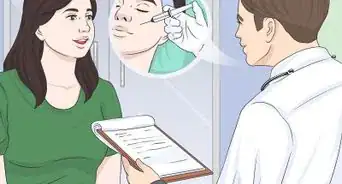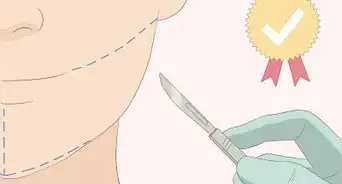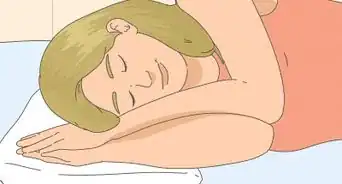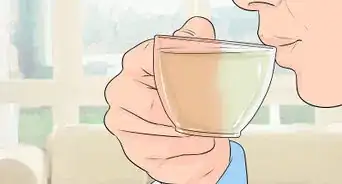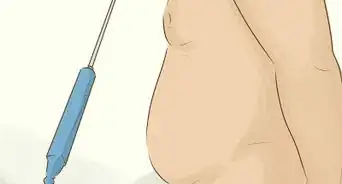This article was co-authored by Danny Gordon. Danny Gordon is an American College of Sports Medicine (ACSM) Certified Personal Trainer and Owner of The Body Studio for Fitness, a fitness studio based in the San Francisco Bay Area. With over 20 years of physical training and teaching experience, he has focused his studio on semi-private personal training. Danny received his Personal Trainer Certification from the California State University, East Bay and the American College of Sports Medicine (ACSM).
There are 18 references cited in this article, which can be found at the bottom of the page.
wikiHow marks an article as reader-approved once it receives enough positive feedback. In this case, 80% of readers who voted found the article helpful, earning it our reader-approved status.
This article has been viewed 309,177 times.
Losing body fat quickly can be difficult, and unfortunately, there are no tricks or special diets that can get you there. But if you commit to eating healthy and exercising regularly, you’ll be able to burn fat, feel great about your body, and be proud of your commitment to your health.
Steps
Eating a Healthy Diet
-
1Limit carbs. Many studies show that one of the best ways to lose excess body fat somewhat quickly is by limiting your total carb intake.[1]
- To lose weight you can follow a variety of diets — low-calorie, low-fat or low-carb. Limiting carbs can help you lose excess fat more effectively than low-calorie or low-fat diets.[2]
- Carbs are found in a wide variety of foods including: grains, fruit, dairy products, legumes and starchy vegetables.
- Limit carbs from the grain group the most. The nutrients found in grains can also be found in other food groups. This allows you to continue to meet your nutrient needs.
- You may also choose to limit starchy vegetables and fruits that are higher in sugar. Limiting these foods still allows you to consume plenty of vegetables and adequate servings of fruit daily.
- Limit grains, potatoes, corn, peas, carrots, beans, lentils, bananas, mangos, pineapples and grapes. These foods are higher in carbohydrate compared to others.
-
2Eat one to two servings of protein at each meal. In addition to following a lower carbohydrate diet, studies also show that eating higher amounts of protein can aid in weight loss.[3]
- Protein helps support lean muscle mass and your metabolism during weight loss. In addition, it helps you stay satisfied longer throughout the day.[4]
- Including at least one to two servings of lean protein at each meal can help you eat adequate amounts each day. One serving is about 4 oz.[5]
- Choose leaner cuts of protein to help minimize calorie intake. Try: legumes (kidney beans, lentils, chick peas, nuts and pumpkin seeds); tofu; soy milk; poultry; fish, eggs; low-fat dairy; and lean beef.[6]
Advertisement -
3Eat five to nine servings of non-starchy vegetables and low-sugar fruits. Both of these food groups offer you a large variety of essential vitamins, minerals and fiber. Fill up on these nutrient-rich foods to help balance your diet.
- Non-starchy vegetables are much lower in carbohydrates and also low in calories. Include 1 cup of denser vegetables like broccoli, cauliflower, Brussels sprouts or asparagus. Serve yourself 2 cups of leafy greens like kale or spinach.[7]
- There are varying levels of sugar in fruit. Stick to 1/2 cup serving of lower sugar fruits like blackberries, blueberries, strawberries and raspberries.[8]
-
4Cut out sugar and refined carbs. There is some evidence that shows excess intake of sugar and other refined carbs leads to more excess body fat, especially in your midsection. Minimize these foods to help you meet your goal.[9]
- Processed foods and restaurant foods often leave out healthy fiber, protein and nutrients found in less processed, more whole foods.
- Processed foods can include: sweetened beverages, TV or frozen dinners and meals, ice cream and other frozen treats, pastries, chips and crackers, canned soups and meals, and cakes or cookies.
- Limit these foods as often as possible. If you do consume them, stick to smaller servings to minimize your intake.
-
5Limit alcohol. People who are trying to lose body fat may also want to avoid alcohol. Studies have also showed that alcohol can lead to increased body fat especially in the midsection.
- Minimize alcohol in your diet while you're trying to lose body fat. This will help you meet your goals faster.
- Once you have lost body fat and you are on a maintenance diet, you can add in a small amount of alcohol consumption. Women should stick to one serving or less and men should consume two servings or less daily.[10]
-
6Don't skip meals. Skipping meals is generally not recommended - even when you're trying to lose weight. This is especially true if you're pairing a weight loss diet with exercise.[11]
- If you skip meals regularly, you're at risk for running low on nutrients throughout the day.[12]
- Although you may notice increased weight loss when you skip meals, your weight loss may actually be coming from the loss of lean muscle mass, not excess body fat.[13]
- Try to eat regular and consistent meals. Schedule in a meal or snack every three to five hours or as needed.
-
7Incorporate a 12-hour fast. Don't panic — most of this fast occurs while you sleep. Restricting your eating to 12 hours a day may help you lose weight, according to one study.[14] You should still eat your recommended daily calories, but limit yourself to only eating during a 12 hour period. So you might eat breakfast at 7am and cut yourself off from eating after 7pm. Though it is not fully understood, this 12-hour fasting period may cause your body to switch from burning food to burning fat.
Incorporating an Exercise Routine
-
1Start interval training. High-intensity interval training (HIIT) has been shown to help burn more body fat compared to other types of workouts.[15] Incorporate a few of these exercise routines to help you meet your goal.
- HIIT workouts also help keep your metabolism elevated hours after you've completed the exercise.[16]
- Start a HIIT workout by exercising at a moderate-intensity for two to three minutes. Then, change to a high-intensity rate for two minutes. Alternate between the intervals of moderate and high intensity.
- You can do a HIIT workout on a treadmill or outside running. Alternate between sprinting and a moderate jog. You can also do this on a stationary bike. For example, many spin classes alternate between levels of high-intensity spinning with more moderate spinning levels.
- Some workout machines have built-in interval workouts that can get you used to the process of interval training; however, you can also incorporate these workouts in walking, swimming, running and cycling. Buy a heart rate monitor to help you assess the intensity of your interval periods.
-
2Include moderate aerobic exercise. In addition to HIIT workouts, it's important to still include some moderate-intensity aerobic exercise. This type of exercise comes with a variety of benefits including weight loss support.[17]
- Do cardiovascular training at least 150 minutes each week — or five times per week for at least 30 minutes per session.[18]
- Warm up for the first five minutes and cool down for the last five minutes of your exercise routine. This helps your body prepare and recover after your workout. Make sure you stretch after your warmup.
- Vary your cardiovascular workouts. Choose two or three workouts that you like to do and mix them up. This is both mentally and physically beneficial to building different muscles and burning fat.
- Some examples of moderate aerobic exercise include: walking, using an Elliptical, doing a dance or aerobics class, and cycling.
-
3Do strength training two to three times per week. Include weight training or resistance training to your exercise routine. Building lean muscle mass can help support your metabolism and desire to burn fat.[19]
- Choose to lift weights or use weight machines on days when you don't do cardio, or do some strength training after a shorter cardio workout.
- Strength training has a variety of benefits. It increases bone density, metabolism and muscle mass overtime.
- Included in strength training are exercises that use your own body weight, such as squats, lunges, push ups and pull ups. Consider adding these exercises, TRX workouts or cardio burn classes to your regular workout routine.
-
4Include one to two rest days a week. Taking a rest day allows your muscles 24 to 48 hours to recover and repair between weightlifting and cardio routines.[20] It's an essential part to your overall workout routine.
- Try to make your rest days active rest days. Avoid sitting all day or being overly sedentary.
- Try doing more restorative exercises or activities like: yoga, walking or going for a leisurely bike ride.
-
5Sit less. Reducing time in front of the computer screen and television will help to burn more calories throughout the day.
- Studies have shown that lifestyle activities, or those things you do on a daily basis, can have similar benefits to aerobic exercises.[21]
- Add walking sessions to your day. In addition to your cardio and strength training, take a walking lunch break or after dinner walk.
- Also add more movement to your day. Pace while you talk on the phone, stand during TV commercial breaks or walk to more destinations instead of driving.
Making Lifestyle Changes
-
1Manage stress. Studies have shown that continuous chronic stress can lead to abdominal obesity or excess fat levels.[22] Managing stress better may help you lose weight and decrease excess fat levels.
- In addition, chronic stress can make it difficult to lose weight. You might feel hungrier and crave more "comfort foods" when you're stressed.
- Try to engage in relaxing activities to help you relieve stress in your life. For example, try: meditating, going for a walk, listening to music, talking to a friend or doodling.
- If you're having difficulty managing stress, consider seeing a behavior therapist for stress management. These health professionals can give you additional guidance and techniques to better manage your stress.
-
2Get adequate sleep. Like stress, poor sleeping habits can also make weight loss and decreasing excess body fat more difficult.[23]
- Studies have shown that those people who don't sleep well or sleep enough pack on more body fat and lose more lean muscle mass. In addition, your levels of ghrelin (your hunger hormone) increase which stimulates your appetite.[24]
- Aim for at least 7-9 hours of sleep each night.[25] This amount is recommended for adults.
- Try going to bed earlier or sleeping in later to help you meet your nightly goal.
- Also, try turning off cell phones, laptops and TVs prior to going to sleep. This helps you get a more sound sleep.
-
3Weigh yourself at least every week. Studies have shown that regular weigh-ins help you stick to your diet longer term.[26]
- Help yourself stick to your diet plan by getting on the scale on a regular basis. Knowing that you have a regular weigh-in can help motivate you to stay on track with your diet and exercise routine.
- Try to weigh yourself one to two times a week. This will give you the most accurate view of your weight loss trend.
- Remember, although you want to lose body fat, you'll see the reduction of body fat reflected in your overall weight loss.
Expert Q&A
Did you know you can get expert answers for this article?
Unlock expert answers by supporting wikiHow
-
QuestionWhat can I drink to lose body fat?
 Danny GordonDanny Gordon is an American College of Sports Medicine (ACSM) Certified Personal Trainer and Owner of The Body Studio for Fitness, a fitness studio based in the San Francisco Bay Area. With over 20 years of physical training and teaching experience, he has focused his studio on semi-private personal training. Danny received his Personal Trainer Certification from the California State University, East Bay and the American College of Sports Medicine (ACSM).
Danny GordonDanny Gordon is an American College of Sports Medicine (ACSM) Certified Personal Trainer and Owner of The Body Studio for Fitness, a fitness studio based in the San Francisco Bay Area. With over 20 years of physical training and teaching experience, he has focused his studio on semi-private personal training. Danny received his Personal Trainer Certification from the California State University, East Bay and the American College of Sports Medicine (ACSM).
Certified Personal Trainer Water! It's good for your metabolism, it'll keep you hydrated, and it will help you maintain a healthy body. Sugary drinks and alcohol are just going to pump your body full of sugar and sodium, which won't help you lose weight. Remember, you have to use a combination of exercise and healthy eating to effectively lose weight. You can't just sit at home drinking water and expect to lose any weight!
Water! It's good for your metabolism, it'll keep you hydrated, and it will help you maintain a healthy body. Sugary drinks and alcohol are just going to pump your body full of sugar and sodium, which won't help you lose weight. Remember, you have to use a combination of exercise and healthy eating to effectively lose weight. You can't just sit at home drinking water and expect to lose any weight! -
QuestionDoes protein help you lose belly fat?
 Danny GordonDanny Gordon is an American College of Sports Medicine (ACSM) Certified Personal Trainer and Owner of The Body Studio for Fitness, a fitness studio based in the San Francisco Bay Area. With over 20 years of physical training and teaching experience, he has focused his studio on semi-private personal training. Danny received his Personal Trainer Certification from the California State University, East Bay and the American College of Sports Medicine (ACSM).
Danny GordonDanny Gordon is an American College of Sports Medicine (ACSM) Certified Personal Trainer and Owner of The Body Studio for Fitness, a fitness studio based in the San Francisco Bay Area. With over 20 years of physical training and teaching experience, he has focused his studio on semi-private personal training. Danny received his Personal Trainer Certification from the California State University, East Bay and the American College of Sports Medicine (ACSM).
Certified Personal Trainer
-
QuestionWhat is the best protein to eat?
 Danny GordonDanny Gordon is an American College of Sports Medicine (ACSM) Certified Personal Trainer and Owner of The Body Studio for Fitness, a fitness studio based in the San Francisco Bay Area. With over 20 years of physical training and teaching experience, he has focused his studio on semi-private personal training. Danny received his Personal Trainer Certification from the California State University, East Bay and the American College of Sports Medicine (ACSM).
Danny GordonDanny Gordon is an American College of Sports Medicine (ACSM) Certified Personal Trainer and Owner of The Body Studio for Fitness, a fitness studio based in the San Francisco Bay Area. With over 20 years of physical training and teaching experience, he has focused his studio on semi-private personal training. Danny received his Personal Trainer Certification from the California State University, East Bay and the American College of Sports Medicine (ACSM).
Certified Personal Trainer
References
- ↑ http://www.mayoclinic.org/healthy-lifestyle/weight-loss/in-depth/low-carb-diet/art-20045831
- ↑ http://www.mayoclinic.org/healthy-lifestyle/weight-loss/in-depth/low-carb-diet/art-20045831
- ↑ http://www.womenshealthmag.com/weight-loss/protein-weight-loss
- ↑ Danny Gordon. Certified Fitness Coach. Expert Interview. 18 October 2019.
- ↑ http://www.choosemyplate.gov/protein-foods
- ↑ Danny Gordon. Certified Fitness Coach. Expert Interview. 18 October 2019.
- ↑ http://www.choosemyplate.gov/vegetables
- ↑ http://www.choosemyplate.gov/fruit
- ↑ http://www.uhs.berkeley.edu/Facstaff/pdf/healthmatters/NutritionActionSugarBellyApril%202012.pdf
- ↑ http://www.cdc.gov/alcohol/faqs.htm
- ↑ http://www.prevention.com/weight-loss/effects-skipping-meals
- ↑ http://www.prevention.com/weight-loss/effects-skipping-meals
- ↑ http://www.prevention.com/weight-loss/effects-skipping-meals
- ↑ http://www.cell.com/cell-metabolism/abstract/S1550-4131%2814%2900498-7
- ↑ http://www.shape.com/fitness/workouts/8-benefits-high-intensity-interval-training-hiit
- ↑ http://www.shape.com/fitness/workouts/8-benefits-high-intensity-interval-training-hiit
- ↑ http://www.cdc.gov/physicalactivity/basics/pa-health/index.htm
- ↑ http://www.cdc.gov/physicalactivity/basics/adults/
- ↑ http://www.cdc.gov/physicalactivity/basics/adults/
- ↑ http://www.bodybuilding.com/fun/behar2.htm
- ↑ http://www.ncbi.nlm.nih.gov/pubmed/0009929086
- ↑ http://onlinelibrary.wiley.com/doi/10.1046/j.1467-789x.2001.00027.x/pdf
- ↑ https://www.psychologytoday.com/blog/the-source-healing/201010/sleep-more-burn-more-fat
- ↑ https://www.psychologytoday.com/blog/the-source-healing/201010/sleep-more-burn-more-fat
- ↑ https://www.psychologytoday.com/blog/the-source-healing/201010/sleep-more-burn-more-fat
- ↑ http://www.apa.org/monitor/nov07/daily.aspx
About This Article
If you’re already working on eating less, the best way to lose body fat fast is to eat more protein, such as beans, eggs, and meat, and avoid sugar, alcohol, and processed foods. Avoid eating after dinner, but make sure you’re eating regular meals and snacks every 3-5 hours. Do high-intensity interval training to burn fat efficiently, and mix in strength training to support your metabolism. For advice from our Fitness reviewer on how to make lifestyle changes and manage stress to lose body fat, read on!

